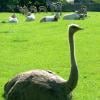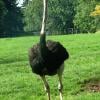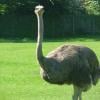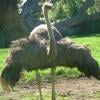Due to its weighty body, flat breastbone and loose feathers it means they are unable to fly and are instead built to run, being able to reach speeds of up to 43mph. Native to the African savannah they are widespread across the continent living in small groups usually containing an alpha male and female along with several less dominant hens.
The beginning of their breeding season involves the male scraping out a nest in a suitable place. He then has to attract the females by performing an elaborate courtship display which involves him crouching down, opening his wings and doing a ‘dance’. If successful, the females will then lay their fertilised eggs in the communal nest created by the male, which is around 3m wide. Ostriches lay the biggest eggs of any bird throughout the world, around 20 times the size of a chicken egg. They are a glossy-cream colour with a thick shell and are marked by distinctive small pits all over them.
The dominant female of the group will lay her eggs first which may be up to 11 eggs. The lesser females will then lay theirs, usually around 2-6 in the same nest. The dominant female may later discard the weaker hens eggs from the nest close to the time of incubation as each female can distinguish her own eggs from others. This generally leaves around 20 eggs ready to be incubated. The incubation period lasts between 42-46 days. The eggs are incubated by the main female during the day and by the male during the night due to the difference in colour of their feathers. Female feathers are brown/grey helping them blend in with their sandy habitat whereas male feathers are black making them virtually undetectable at night. This helps camouflage nests from potential predators leading to greater survival.
ConservationStatus
Least Concerned
Near Threatened
Vulnerable
Endangered
Critically Endangered
Extinct In The Wild




